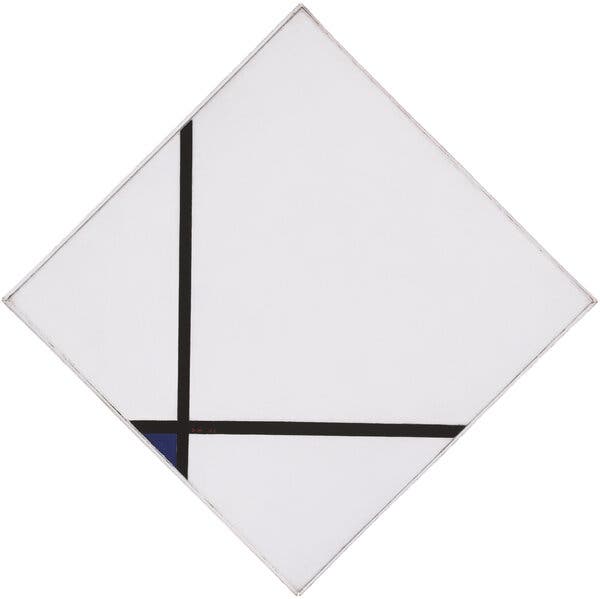News:
Heirs Sue to Claim Mondrian Painting in Philadelphia Museum of Art
By Catherine Hickley
The lawsuit argues that Piet Mondrian, the artist, never lost title to the painting, which was looted by the Nazis and has been in the museum since 1943.
Composition with Blue (Schilderij No. 1: Lozenge with 2 Lines and Blue)," 1926, by Piet Mondrian
The heirs of Piet Mondrian have sued the Philadelphia Museum of Art to claim a painting by the Dutch artist that was confiscated by the Nazis as “degenerate” art and that they argue is “in the wrongful possession” of the museum, which received it as a gift nearly 70 years ago.
A pioneer of abstract art, Mondrian painted “Composition With Blue” — a work comprising two black lines against a white background and a small triangle of blue — while living in Paris in 1926. It is one of just 17 lozenge-shaped works that the artist produced.
Representatives of Mondrian’s heirs say it is worth at least $100 million today.
They argue that Mondrian never lost title to the painting, which the Nazis confiscated in 1937 and then put up for sale, and so ownership of the painting is retained by his heirs.
“American museums should no longer keep Nazi-looted art in their collections,” said Lawrence M. Kaye of Kaye Spiegler PLLC, the New York law firm representing the heirs. The suit was filed at the Philadelphia County Court of Common Pleas on Dec. 10.
Timothy Rub, the director and chief executive officer of the Philadelphia Museum of Art, said the museum “fully supports the restoration of art work looted by the Nazis” and has returned artifacts lost during World War II to museums in Dresden, Germany, and the Czech Republic.
But in the case of “Composition With Blue,” Rub said that neither Mondrian nor the friend he named as his first heir ever pursued a claim to the work, which came to the museum in 1943, initially on loan from a private collector.
Mondrian died in New York in 1944, bequeathing his entire estate to his close friend, the artist Harry Holtzman. The plaintiffs are Holtzman’s three children.
“Why now?” Rub asked of the heirs’ claim. “The facts of the ownership have not changed.”
Mondrian had consigned “Composition With Blue” to the German art historian and dealer Sophie Küppers soon after completing it. The following year, in 1927, Küppers emigrated to the Soviet Union and left the painting at the Provinzialmuseum in Hanover for safekeeping.
But after the Nazis came to power, “Composition With Blue” was confiscated as “degenerate” in the merciless purge of modern art from German museums that was orchestrated by Propaganda Minister Joseph Goebbels. More than 20,000 works were seized from about 100 museums and stored in a wheat silo in Berlin. “Composition With Blue” still bears the inventory sticker identifying it as “entartete Kunst,” or degenerate art.
Judged by the Nazis to be marketable abroad, the painting was then given to Karl Buchholz, one of a select group of art dealers appointed by Adolf Hitler to sell “degenerate” works to foreign buyers. Buchholz sent it to his New York-based business partner Curt Valentin to sell in the United States.
Among the potential customers Valentin contacted was Alexander Dorner, the former director of the Hanover museum, who had fled the Nazis and headed the Rhode Island School of Design Museum. Dorner was keen to buy the works that had been confiscated from the museum he once led. But he recognized that “Composition With Blue” had belonged, not to the museum, but to a private person and he declined, according to research conducted for the heirs by Gunnar Schnabel, a German lawyer, and Monika Tatzkow, a provenance researcher.
Valentin then sold it to Albert E. Gallatin, a New York collector, in 1939. Gallatin appears to have believed that the painting belonged to the Hanover museum before it was seized. In the face of public criticism of U.S. collectors who purchased art confiscated from German museums, he is quoted in The New York Times on Oct. 29, 1939, saying that if the Nazis were one day ousted, “it is proposed to restore these paintings, should their return be desired, to the museums where they once hung.”
Mondrian, who left Paris in 1938, before World War II broke out, ended up in New York, where Gallatin lived. In December 1939, he wrote to Gallatin, saying, “I was very glad to hear about the exhibition that you arranged of my work, and that my Hannover-picture is so well placed now.” He later agreed to restore the painting for Gallatin — evidence, according to Rub at the Philadelphia Museum of Art, that Mondrian acknowledged and accepted Gallatin’s ownership.
The heirs, however, argue that as World War II still raged, Mondrian didn’t realize that he retained a valid claim to property seized by the Nazis, perhaps because he assumed incorrectly that expropriations by the German government in power had been legal. In fact, the heirs argue, even under Nazi law, confiscating art from non-German private individuals was prohibited.
“He didn’t think he had a right to it and then he died before the war ended,” said Kaye, the heirs’ lawyer.
After first loaning the painting to the Philadelphia Museum of Art, Gallatin bequeathed it to the museum on his death in 1952.
According to a statement from their lawyers, the heirs only learned that they retained legal ownership of the painting through the research by Schnabel and Tatzkow. On learning their findings, the Holtzmans first approached the museum in 2018 in an attempt to settle the dispute out of court.
“We are greatly disappointed that we have been compelled to take legal action to enforce our rights,” said Madalena Holtzman, one of the heirs.
https://www.nytimes.com/2021/12/13/arts/design/mondrian-painting-philadelphia-museum-of-art-lawsuit.html


